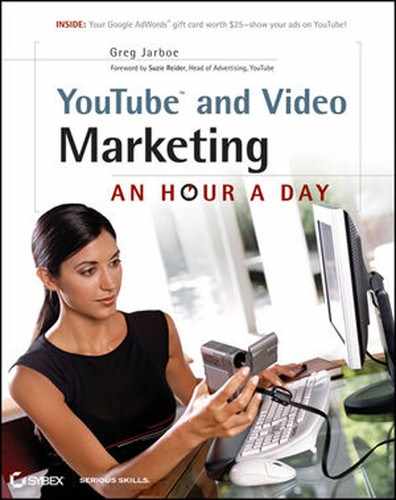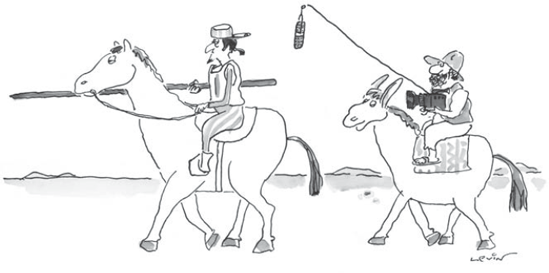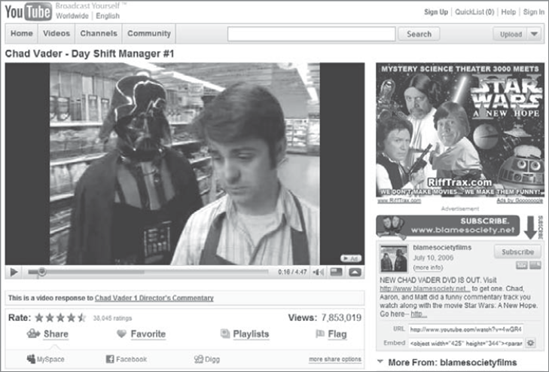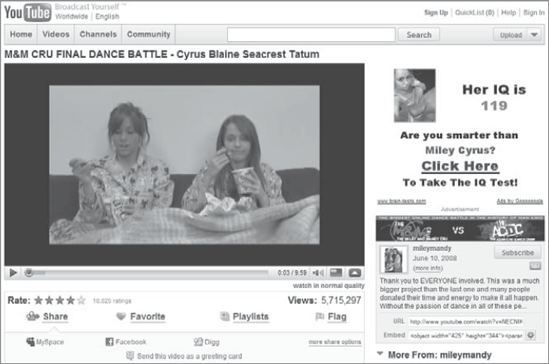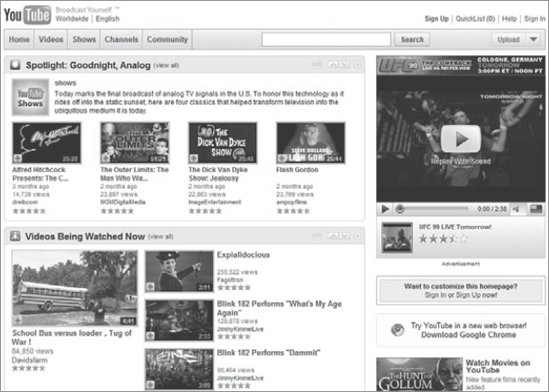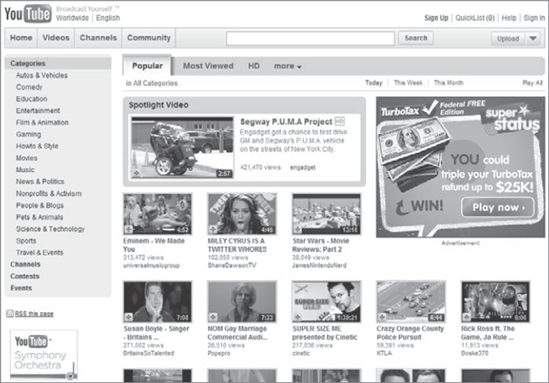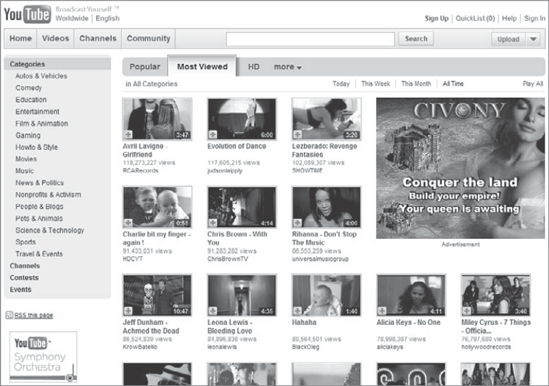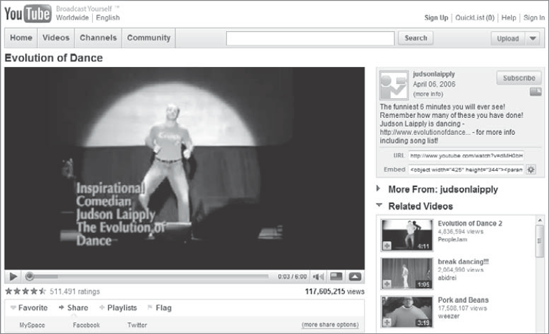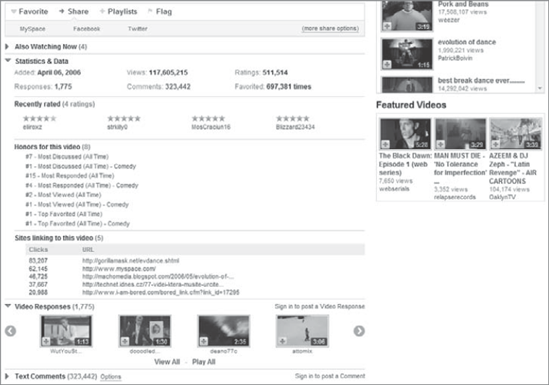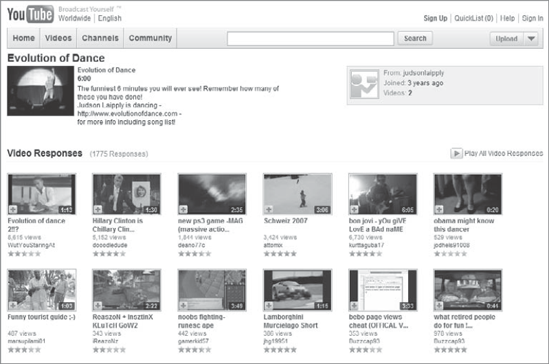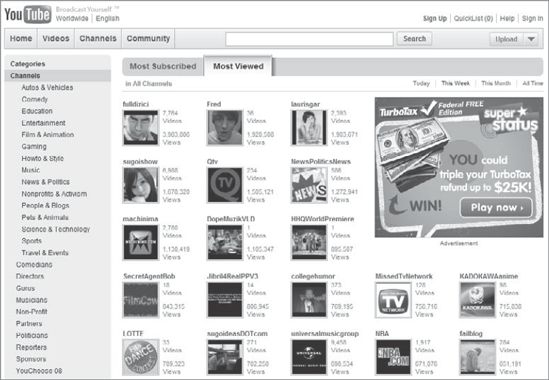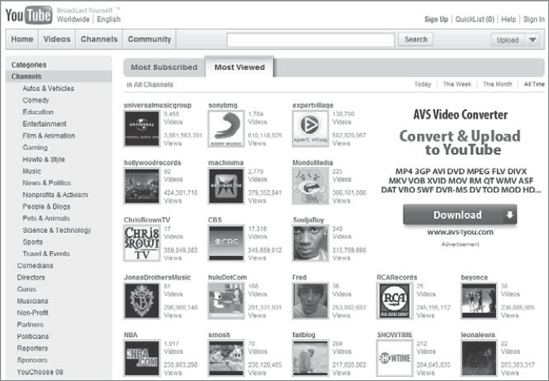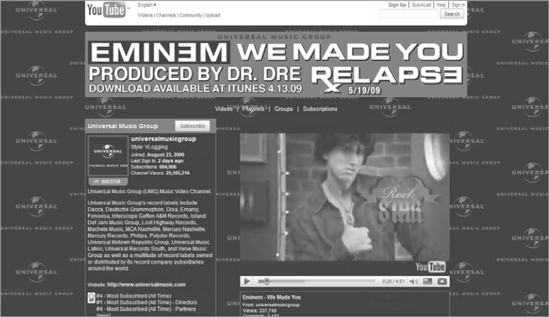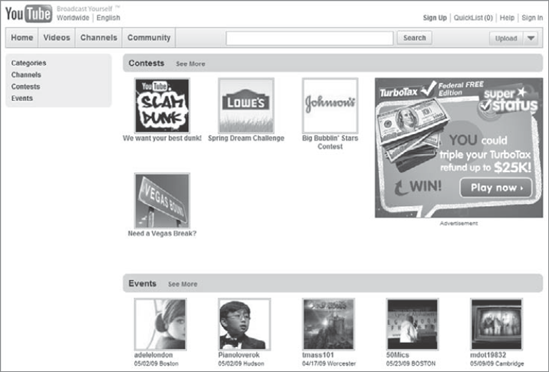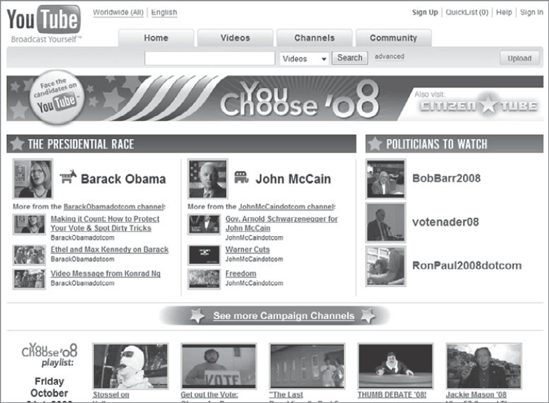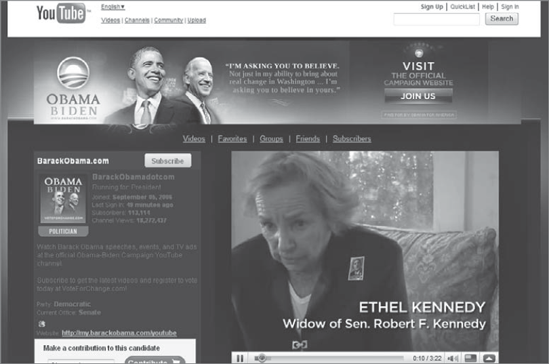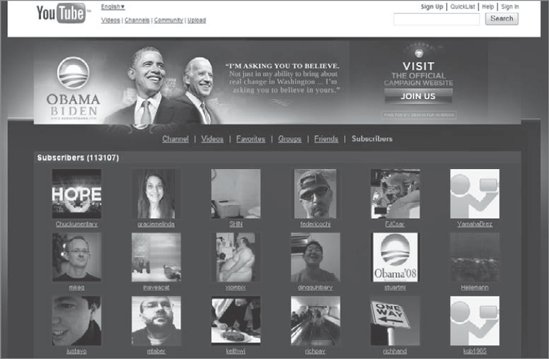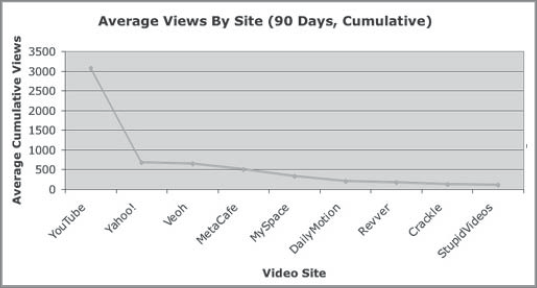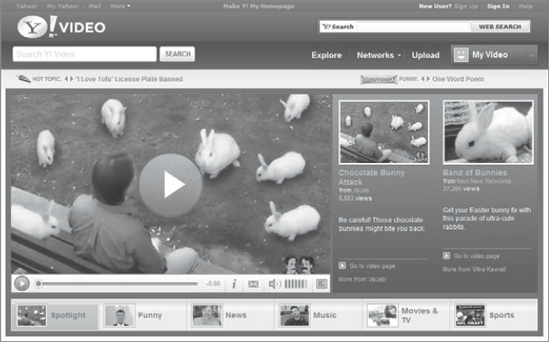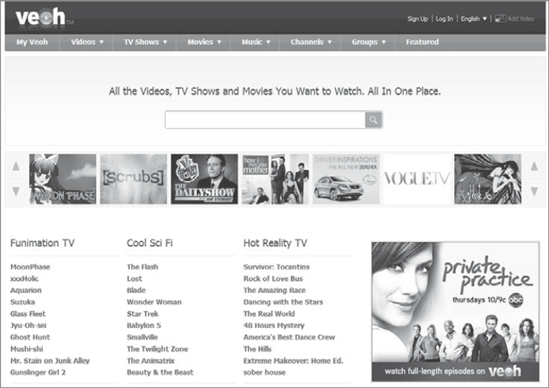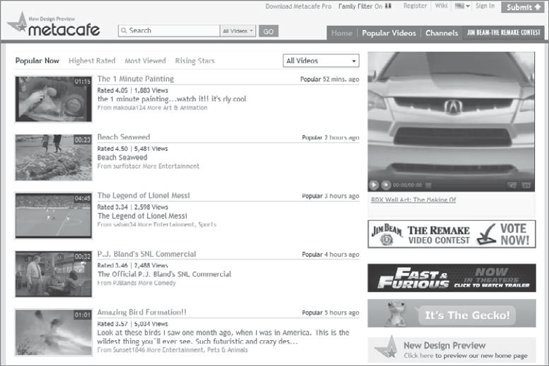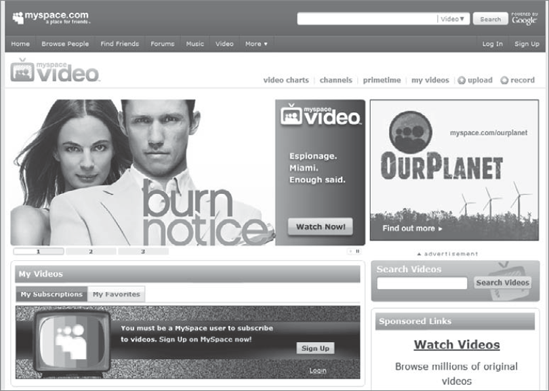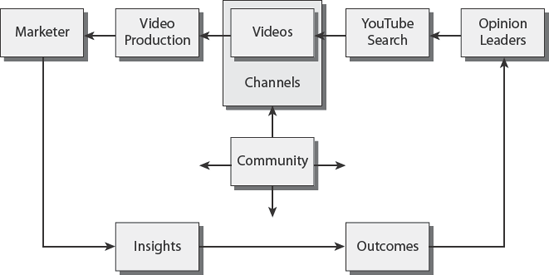In the previous chapter, you learned about opinion leaders. In this chapter, you will learn how to identify opinion leaders on YouTube and other online video sites. You will also learn why the old communication model should be reversed to map out your video marketing strategy. This quest will require all of the imagination, passion, and discipline of Don Quixote plus the practicality, realism, and cleverness of Sancho Panza.
Chapter Contents
Tilting at Windmills
Week 1: Identify Opinion Leaders on YouTube
Week 2: Find Opinion Leaders on Other Video Sites
Week 3: Reverse the Old Map of Mass Media
Week 4: Follow the New Map of Social Media
When mapping out their video marketing strategy, many veteran marketers start by setting their marketing goals and advertising objectives. But riddle me this: How can you set practical goals and realistic objectives if you haven't identified your target audience first?
And many new YouTubers will start by shooting first and asking questions later. But riddle me that: If you haven't identified your target audience first, how can you hope to get at least 100 views?
This is why I'll talk about creating compelling video content in Chapter 5 and setting your goals and objectives in Chapter 9 after identifying your target audience in this chapter. As Figure 3.1 illustrates, it may appear that I'm tilting at windmills.
But I'm just borrowing a page from classic marketing, which starts by determining the needs and wants of target markets. Actually, I'm just borrowing a paragraph from "Marketing Myopia," the classic article by Theodore Levitt published in the Harvard Business Review in 1960. According to Levitt:
Hollywood barely escaped being totally ravished by television. Actually, all the established film companies went through drastic reorganizations. Some simply disappeared. All of them got into trouble not because of TV's inroads but because of their own myopia....Hollywood defined its business incorrectly. It thought it was in the movie business when it was actually in the entertainment business. 'Movies' implied a specific, limited product. This produced a fatuous contentment that from the beginning led producers to view TV as a threat. Hollywood scorned and rejected TV when it should have welcomed it as an opportunity—an opportunity to expand the entertainment business.
Although this was written almost 50 years ago, it should still be required reading today. Only now, television seems to be playing the old role Hollywood once played and online video is playing the role of TV.
Levitt added, "Had Hollywood been customer oriented (providing entertainment) rather than product oriented (making movies), would it have gone through the fiscal purgatory that it did? I doubt it."
So, let's not make the same mistake that "decimated the old movie companies and toppled the big movie moguls." Instead, let's start by identifying who our target viewers are—and what they are seeking, when they seek it, where they seek it, and why they seek it—before we decide how to inform, persuade, or entertain them.
In the mass marketing era, less effort needed to be spent identifying who your target viewers were. They seemed to be everyone who could be reached via mass media.
In today's social marketing era, more effort needs to be spent identifying who your target viewers should be. They are the opinion leaders who discover new videos on a daily basis and then decide to share some of them with others a few times a week using social media.
However, you learned in Chapter 2 that you can often identify opinion leaders by their behavior. As Figure 3.2 illustrates humorously, opinion leaders like Chad Vader, Day Shift Manager, are more likely to have either rated an online video or posted comments after seeing a video online.
As Figure 3.3 illustrates musically, opinion leaders like Miley Cyrus and Mandy Jiroux are more likely to have uploaded a video file online for others to watch, such as their "M&M CRU" dance battle videos.
And as you will see in Chapter 7, opinion leaders are more likely to share links with others by posting them to a website or blog.
Using these visible signs, it is possible to identify the opinion leaders on YouTube. They are who your target viewers should be. Here's how:
Monday: Visit YouTube's home page
Tuesday: Click the Videos tab
Wednesday: Click the Channels tab
Thursday: Click the Community tab
Friday: Visit You Choose '08
To begin, let's visit YouTube's home page: www.youtube.com. Now, if you already have a YouTube Account, please log out. I want you to see YouTube's home page the way visitors without accounts would see it.
Everyone signed out?
Entrepreneur: "Before we begin today's lesson, should I turn off my cell phone, beeper, and iPod, too?"
No, that won't be necessary.
As Figure 3.4 illustrates, tabs for Home, Videos, Shows, Channels, and Community appear across the very top of the YouTube home page. To the right of these tabs is a search box. We'll explore these areas in more detail over this coming week.
Spotlight videos are prominently displayed at the top of the home page. Although they don't appear every day, when they do, Spotlight videos are organized around a theme like the final broadcast of analog TV signals in the U.S.
Lower down, thumbnails of four videos being watched now appear. On days without spotlight videos, videos being watched now appear at the top of the home page. Underneath these are thumbnails of four Featured Videos.
Scroll down and there are the most popular videos in eight categories, as well as the overall most viewed and top favorited video. And over on the right side are advertisements, which YouTube calls "Promoted Videos." If some of these monikers seem new, they are. YouTube renamed a few modules in March 2009 and made other changes to the homepage in April 2009
In June 2008, YouTube introduced a personalized home page. The customizable home page featured new interactive modules that could be moved around, removed, and replaced to create a more personal video discovery experience.
The new home page included the latest videos from subscriptions, personalized recommendations (an algorithmically selected set of videos based on past views and favorites), and an easier way to see what friends were uploading, favoriting, and rating as well as home page regulars like featured videos and videos being watched now.
In addition, the new personalized home page featured a dashboard that included stats about the user's Inbox. This is significant because it means veteran Tubers and new YouTubers are probably getting very different answers to the question, "What should I watch today?"
YouTube Director: "How do you get featured on YouTube?"
That's a good question. Featured Videos are primarily populated with videos from YouTube's thousands of partners, but they might also include select user videos that are currently popular or that YouTube has previously showcased in Spotlight Videos. YouTube automatically rotates these videos throughout the day to keep them fresh.
"How do you get featured on YouTube" is also the title of an animated short that is also called "The Birds and the Biz" from Jantze studios. As the thumbnail in Figure 3.5 illustrates, it finally explains the secret behind getting your work featured by YouTube.
According to Papa Bear, "YouTubers have a better chance of having their films featured on the site by not only creating original work but also by becoming a fully vested member of the YouTube community."
YouTube Director: "And how do you become a fully vested member of the YouTube community?"
Well, according to pops, "It all starts with creating a channel and uploading a video. If you want to increase your presence, you make playlists, join groups, subscribe to other videos, and get involved just like you would with any other community."
He adds, "By joining groups, replying to other videos, even making more videos, you'll build a following and have a better chance of catching the eye of one of those busy YouTube bees."
YouTube Director: "Those busy YouTube bees sound like an anthropomorphic version of opinion leaders, if you ask me."
I agree. As we'll discuss later in this chapter, opinion leaders have greater social participation than their followers.
YouTube Director: "Do only the most-viewed videos get picked?"
No. According to pops, "YouTube only pays attention to what the community is doing and they never really know what crazy new thing will be next." Go to www.youtube.com/watch?v=3eZTh94Fapg to watch the entire animated film. It's one of the favorites in YouTubeHelp's channel.
YouTube Director: "How do you get spotlighted on YouTube?"
That's another good question. According to YouTube, "The YouTube Team likes to highlight videos they think users want to watch; videos that hopefully inform, inspire, and entertain."
As of this writing, YouTube is planning to take a more thematic approach to showcasing some of the best videos the YouTube community and partners produce. When you see these videos, they will have top billing on the page—a true spotlight.
Now, click the Videos tab (http://www.youtube.com/browse) at the top of the YouTube home page. As you can see in Figure 3.6, this will take you to the Videos page, where you'll see some new elements.
For starters, there is a link at the top that says Spotlight Video. Selected by the YouTube Editors, it's a "cool video you might be interested in" feature. Yes, the YouTube Editors can be opinion leaders too.
Underneath are 23 Popular videos in all categories. And other tabs across the top of the page are Most Viewed, and HD, and more. These are called Honors and are given to videos by the YouTube community.
Down the left side of the Videos page are 16 Categories:
Autos & Vehicles
Comedy
Education
Entertainment
Film & Animation
Gaming
Howto & Style
Movies
Music
News & Politics
Nonprofits & Activism
People & Blogs
Pets & Animals
Science & Technology
Sports
Travel & Events
These categories are selected by YouTubers when they upload a new video.
Click the Most Viewed tab and then the All Time link, as you can see in Figure 3.7.
Underneath that are the most viewed videos of all time: "Avril Lavigne - Girlfriend" (with over 118 million views as of April 2009) and "Evolution of Dance" (with over 117 million views). We looked at the music video from RCA Records in Chapter 2, so click "Evolution of Dance" to see Judson Laipply's dancing comedy in Figure 3.8.
Added on April 6, 2006, Jud says his video is "the funniest 6 minutes you will ever see!" His video amassed over 10 millions views in under two weeks and has been featured on Good Morning America, The Today Show, and countless others. So, the public and the press agree.
As Figure 3.9 shows, when you scroll down, you'll see Statistics & Data. Click on the triangle on the left and you will see this video not only had more than 117 million views, it also had over 511,000 ratings, 1,775 responses, and more than 323,000 comments. In addition, it had been favorited more than 697,000 times and received eight honors, including #1 Top Favorited (all time), #7 Most Discussed (all time), and #15 Most Responded (all time).
Underneath this, you'll see the top five sites linking to this video—ranked by which ones sent the most clicks to "Evolution of Dance." That's a qualified list of opinion leaders from outside the YouTube community.
Next, you'll see 1,775 video responses to "Evolution of Dance." Click on the "View All" link and you'll see how many of these are an homage by an opinion leader in the comedy category.
Underneath this, you'll see more than 323,000 text comments. Read a sample of these comments and you'll see that some are spam, but many are by opinion leaders.
How can you tell if a comment is spam? As Justice Potter Stewart once said about obscenity, "I know it when I see it."
Now, click the Channels tab (http://www.youtube.com/members) at the top of the YouTube home page. As Figure 3.11 illustrates, this will take you to the Channels page, where you'll see some more new elements.
To begin with, there are two links across the top: Most Subscribed and Most Viewed. Again, these honors are given to channels by the YouTube community.
Down the left side of the Channels page are 15 categories (as of this writing, Movies wasn't listed on the Channels page). Underneath are nine different account types, which are selected when a new brand channel is created on YouTube, and links to You Choose 08 (which we'll look at on Friday):
Comedians
Directors
Gurus
Musicians
Non-Profit
Partners
Politicians
Reporters
Sponsors
You Choose 08
Finally, at the bottom of the list are links to Contests, Events, and the YouTube Screening Room.
As you see in Figure 3.12, click the All Time link and the most viewed channels are Universal Music Group (with over 3.8 billion views as of April 2009) and Sony BMG (with over 610 million views). With almost 9,458 videos, we have to take a look at Universal Music Group's VLogging channel.
In Figure 3.13 is the Universal Music Group (UMG) Music Video Channel. Launched on August 23, 2006, it had almost 665,000 subscribers as of April 2009, making it the #4 most subscribed channel of all time.
This means close to 665,000 subscribers get notified each time UMG uploads a new video, dramatically accelerating the "time-to-take-off" for Universal Music Group's dozens of record labels as well as a multitude of record labels owned or distributed by its record company subsidiaries around the world. However, UMG doesn't display its subscribers, so we can't see who their opinion leaders are.
UMG's channel also had over 25 million channel views as of April 2009. Channel views are the number of times YouTubers look at a user's page, which contains a user's profile information, videos, and other features. This means YouTubers have visited UMG's brand channel more than 25 million times to look for videos, playlists, and groups. This kind of brand loyalty also helps to accelerate the "time-to-take-off" for a new video from UMG.
Now, click the Community tab to go to the Community page (http://www.youtube.com/community), where you'll see additional new elements (Figure 3.14). This includes Contests, Events, Groups, and Community Help Forums.
A contest is a competition where users can submit videos and other users can vote on them. The official YouTube Contests section is for paid advertisers only. Each contest is different so you'll have to check out the particular contest page you're interested in to find out more details about it.
Non-official contests can be created by anyone in any number of ways ranging from the creation of groups to simple video responses.
For example, on August 18, 2008, Better Homes and Gardens magazine's BetterRecipes.com site launched an online video contest to find "America's Next Cooking Celebrity." To enter, all participants had to do was upload a video of them preparing an original recipe to BetterRecipes's YouTube channel, which appears in Figure 3.15.
A panel of judges selected two semifinalists, who were flown to Des Moines, Iowa, for a cook-off in the famous Better Homes and Gardens Test Kitchen. The cook-off aired on the Better Today television show in 30 markets around the country. The winner would also have their very own cookbook published by Better Homes and Gardens.
At that time, an ad on the YouTube home page cost $175,000 a day, plus a commitment to spend $50,000 more in ads on Google or YouTube. For a small fraction of that cost, Better Homes and Gardens hired my company to conduct an outreach program to opinion leaders with cooking blogs or cooking channels on YouTube. We also wrote an optimized press release to promote the contest.
Participants from across the country embraced the challenge in creative ways. The first to respond was Jolene Sugarbaker, "The Trailer Park Queen" and a YouTube guru. She commented on the BetterRecipes's channel, "What a great contest! Jumping into my kitchen now!"
Jolene Sugarbaker's channel had 161 videos, over 6,000 subscribers, and more than 138,000 channel views at the time. She also has an official site, a MySpace page, and a vlog. She was the first opinion leader to adopt the contest.
By the time the contest ended in early October, the introductory video had 21,661 views and there were 75 video responses, making it the #13 most responded video that month in the Howto & Style category, as well as the #40 most responded video of all time in that category.
The two finalists were Rob Barrett, who has the cooking4dads channel on YouTube and the Cooking for Dads website, and Kristina Vanni, who has the kristinavanni channel on YouTube and the Recipe Souvenirs website.
"Hundreds of talented people entered our cooking contest—but Kristina and Rob really stood out from the rest," said Heather Morgan Shott, senior food editor of BHG.com. "They dazzled us with their creativity, cooking chops, and, ultimately, their delicious dishes."
The panel of judges then selected Rob as the winner based on his personality, ability to communicate the creation of his dish to the audience, final presentation, and taste. Rob is not a professional chef, just a dad who has learned to cook fun meals for the whole family.
"Rob is a natural," said Jennifer Darling, executive food editor for Meredith Special Interest Media. "Anyone can follow his directions and his recipes were yummy—great family food. We're all excited to see his Tastebook recipe collection that he's putting together."
Joining a group is one way to become a fully vested member of the YouTube community and build relationships with opinion leaders. If you have some interesting videos and thoughts to contribute, and like participating in conversations with others, you might want to join a group:
From the group's main page, click the Join This Group link in the upper-right corner.
If the group owner allows anyone to join the group, you'll automatically become a member. Otherwise, you'll have to wait until the group owner gives you permission before you can post videos or topics for discussion.
Once you've joined a group, it's easy to post new topics for discussion or add comments to other topics.
YouTube launched You Choose 08 on March 1, 2007. As Figure 3.16 illustrates, the platform featured videos from the presidential campaigns, the news media, and other contributors.
The first presidential candidate in the spotlight was Mitt Romney, who posted a video on April 11, 2007, asking the YouTube community a question, monitored response videos for a week, and then posted another video reflecting on what he'd seen.
Romney was followed by John Edwards on April 18, John McCain on April 25, Dennis Kucinich on May 1, Duncan Hunter on May 9, Hillary Clinton on May 16, Mike Huckabee on May 23, Joe Biden on May 30, Tom Trancredo on June 7, Barack Obama on June 17, Sam Brownback on June 20, Chris Dodd on June 28, Jim Gilmore on July 5, Bill Richardson on July 11, Rudy Giuliani on July 18, Mike Gravel on July 28, and Ron Paul on August 5. Millions of people checked out the candidates' YouTube channels, and thousands communicated directly with those running for president via ratings, comments, and video responses.
On June 14, 2007, YouTube announced another way of bringing that dialogue to national television: the CNN/YouTube debates. The Democratic debate on July 23 and the Republican debate on November 28 featured questions from YouTube videos.
Eight Democratic presidential candidates faced 39 questions about the war in Iraq, the environment, health care, education (sex and otherwise), gay marriage, and lots more. The questions were direct, heartfelt, and even brought some levity to politics. For example, as Figure 3.17 illustrates, Billiam the Snowman from kotasHQ asked the Democratic candidates about global warming.
People submitted almost 5,000 questions to the GOP hopefuls right on YouTube, 2,000 more than the Democrats got. And the eight Republican candidates sparred on 34 of these important issues, including the economy, Iraq, and immigration.
In other words, the "invisible caucus" of opinion leaders in YouTube's News & Politics category that I mentioned in Chapter 2 was very visible. Did it impact the real caucuses and primaries held in 2008?
That's the question that politicians seeking office in 2010, 2012, and beyond need to ask.
As I mentioned earlier, the Pew Internet & American Life Project reported in June 2008, that 35 percent of Americans had watched online political videos—a figure that nearly tripled the reading Pew got in the 2004 race. And 51 percent of wired Democrats and Independents had watched some type of political campaign video, compared with 42 percent of wired Republicans. In addition, Obama supporters outpaced McCain supporters in their usage of online video.
Aaron Smith, a research specialists, and Lee Rainie, director of the Pew Internet Project, said, "The punch-counterpunch rhythms of the campaign are now usually played out online in emails and videos rather than in faxed press releases and 30-second ads."
What impact did online video have on the outcome of the 2008 presidential election?
As Figure 3.18 illustrates, BarackObamadotcom's channel on YouTube, which had been launched on September 5, 2006, had just over 113,000 subscribers and 18+ million channel views as of November 1, 2008. The 1,760 videos on the channel had 93,929,314 views all time.
And as you can see in Figure 3.19, clicking the subscriber's link showed you the photos and names of the opinion leaders who followed the Obama campaign.
JohnMcCaindotcom's channel on YouTube, which had been launched on February 23, 2007, had 28,000 subscribers and over 2 million channel views on that date. And the 327 videos on the channel had over 24 million views all time. But the McCain campaign didn't display the photos and names of their subscribers, so we don't know who the opinion leaders who followed the McCain campaign were.
Overall, Obama's videos on YouTube had almost a 4-to-1 lead over McCain's videos in total views and a 4-to-1 lead and a 9-to-1 lead in channel views the Saturday before Tuesday's presidential election.
In the previous month, Obama's videos had 16+ million views compared to almost 4 million views for McCain's. In the previous week, Obama's videos had over 4 million views compared to 633,000 views for McCain's. Although on Election Day, McCain's videos had almost 140,000 views compared to 91,000 views for Obama's, it was of course too little too late.
Based on its market share, I believe YouTube should be the center, but not the circumference, of your video marketing strategy. So let's take a serious look some of the other online video sites to see if we can find opinion leaders there as well. But which other online video sites merit a serious look?
It's difficult to identify opinion leaders who use Google Video or blinkx because video search engines don't invite users to post comments.
Although there are scores of video sharing sites, only a handful have a market share that's greater than 1 percent. For example, TubeMogul took a sample of 200,000 videos on July 17, 2008. It then compared average cumulative views for the following sites: Crackle, Dailymotion, Metacafe, MySpace, Revver, Stupid Videos, Veoh, Yahoo! Video, and YouTube.
As Figure 3.20 illustrates, although YouTube dominated in cumulative views, the seven other online video sites still reach a great deal of the audience out there.
Adding up the video sharing site averages, veteran marketers and new YouTubers can almost double their audiences by distributing their videos to Yahoo! Video, Veoh, Metacafe, MySpace, and Dailymotion as well as YouTube.
Let's explore these video sharing sites and see what happens if we say, "Take me to your opinion leaders":
Monday: Start with Yahoo! Video
Tuesday: Check out Veoh
Wednesday: Look at Metacafe
Thursday: Watch MySpace Video
Friday: View Dailymotion
Let's start at Yahoo! Video (http://video.yahoo.com), where 45.4 million unique viewers watched an average of 7.8 videos per viewer in April 2009 according to comScore Video Metrix. That's a total of 355.2 million videos—or a 2.1 percent share of all the videos viewed in the United States that month.
In Canada, comScore Video Metrix reported that Yahoo! Video was the #3 video property in February 2009. And TubeMogul reported in July 2008 that Yahoo! Video was #2 in average views by site, behind only YouTube. This is one of the places to look for opinion leaders.
As you can see in Figure 3.21, Yahoo! Video is a pop-culture mashup. It has unicorns, chipmunks, ninjas, cats, and robots. It also has music videos and news, sports, autos, comedy, TV clips, and movie previews.
The people at Yahoo! Video handpick the most original and up-to-date videos for your viewing pleasure, from user-created content to exclusive Web shows. So, they are some of the opinion leaders that you will want to get to know.
In addition, uploading your videos to Yahoo! Video will help them show up in the blended results in Yahoo! Search.
To get started, create a personal profile. Then view, rate, and review videos. Demonstrate your good taste by programming and sharing your own personal playlists. And check out the Yahoo! Video Blog to find out what the people behind Yahoo! Video have to say about the world of online video.
If you dig deeper, you'll see that Yahoo! Video displays comments from other viewers. Many of these comments were made by opinion leaders in the Yahoo! Community.
Today, let's check out Veoh (http://www.veoh.com), an Internet TV service that gives viewers the power to easily discover, watch, and personalize their online viewing experience. It ranked #3 in TubeMogul's research.
As you can see in Figure 3.22, Veoh gives you free access to a wide variety of TV and film studio content, independent productions, and user-generated videos on the Web. This includes hit CBS, NBC, FOX, and Comedy Central shows as well as YouTube clips.
Veoh is an open platform for content publishers of all sizes and sophistication. As of October 2008, more than 100,000 content publishers—from CBS, Viacom's MTV Networks, ABC, Warner Bros. Television Group, ESPN, and Lions Gate to thousands of independent filmmakers and content producers—used Veoh to connect with an audience of more than 28 million unique users per month worldwide.
In addition, Veoh offers a unique publisher optimization program that gives marketers tools to help them raise awareness of their content and cultivate loyal viewing audiences.
Veoh also displays the comments of viewers underneath individual videos, enabling you to identify the most engaged, influential viewers. According to Veoh, about 6 million of its U.S. viewers are considered "engaged viewers" who watch more than an hour of online video a week.
You might also want to check out "Watching The Web: How Online Video Engages Audiences," a study entitled commissioned by Veoh Networks and conducted by Forrester Consulting that found in October 2008, "not all online video viewers are created equal."
The study found "engaged viewers" make up nearly 40 percent of all online video viewers and watch nearly 75 percent of all online video. Engaged viewers who spend the most time watching and sharing long-form content have certain characteristics:
They are more likely to watch videos all the way through.
They pay more attention to online video than they do TV.
They interact with and rate the videos they watch more frequently.
They are twice as likely to recall in-video ads and post-rolls than nonengaged viewers.
They agree more readily that advertising is fair and helps pay for their free experience.
They consider banner ads and ads that come in between videos (mid-rolls) most effective.
Today, let's take a look at Metacafe (http://www.metacafe.com/), a video entertainment site that attracted more than 44 million unique viewers worldwide in December 2008, according to comScore Media Metrix. More than 11 million of these unique viewers are in the United States.
As you can see in Figure 3.23, Metacafe is focused exclusively on short-form entertainment from new, emerging talents and established Hollywood heavyweights alike.
Metacafe is not a video sharing site that allows any and every video to be posted. Instead, Metacafe focuses on two key initiatives launched in 2008:
Teaming with content partners in key short-form entertainment categories including TV clips, movie trailers, music videos, sports highlights, video game trailers, comedy sketches, news, and animated videos;
Growing usage of Wikicafe, which empowers the Metacafe community to add and edit the tags, titles, descriptions and more for any of the millions of videos on the site, helping improve video search results and recommendations.
Recent Metacafe initiatives include:
A new NBA channel, which features game highlights, top plays and weekly recaps.
A new Music channel, which features established artists and up-and-coming acts in the genres of Pop, Rock, R&B, Hip Hop, Country and Latin.
The addition of more than 30 featured channels from best-of-the-web content partners and boutique production firms making short-form videos.
The MetaFest online-offline film festival, which honored 26 short films by 23 filmmakers from 10 countries and awarded more than $10,000 in prizes.
Pay particular attention to three features of Metacafe that can help you to identify the opinion leaders in this community:
- Community Auditions
A community review panel of more than 80,000 volunteers takes a first look at each of the thousands of videos submitted to the site every day.
- Community Rankings
The VideoRank system identifies and exposes the most popular videos by automatically gauging every interaction each viewer has with a video.
- Community Rewards
The Producer Rewards program pays video creators for their best original work, as determined by the viewers.
Today, let's watch MySpaceVideo (http://vids.myspace.com/). According to comScore Video Metrix, 49 million viewers in the United States watched an average of 7.9 videos per viewer on MySpace in April 2009. That's a total of 387 million videos—or a 2.3 percent share of all the videos viewed in the United States that month.
And TubeMogul reported on July 17, 2008, that MySpace Video was #5 in average views by site, behind YouTube, Yahoo! Video, Veoh, and Metacafe. So this is another one of the places to look for opinion leaders.
As you can see in Figure 3.24, MySpace Video is similar to the YouTube video sharing site. MySpace introduced MySpaceTV in early 2007 and it is still in beta mode.
Finally, let's view Dailymotion (http://www.dailymotion.com/us). According to comScore, Dailymotion attracted over 44.2 million unique monthly viewers worldwide in January 2009.
As you can see in Figure 3.25, Dailymotion is a video entertainment site. Every day, over 15,000 new videos are uploaded into Dailymotion's global network of 18 localized video entertainment sites. In January 2009, Dailymotion delivered over 914 million videos to users including "curated content" from premium and Motionmaker creative contributors.
In March 2009, Dailymotion announced a distribution agreement with Hulu. The agreement with Hulu will give Dailymotion's audience access to an additional 40,000 premium videos from Hulu's extensive online video library, including full-length episodes from major television studios, full-length feature films from major film studios, as well as news and other content from more than 130 content providers.
As you saw with the previous video sharing sites, you can find opinion leaders on Dailymotion by looking for visible signs like posted comments on videos.
Obviously, there are lots of other online video sites. TubeMogul also looked at Revver, Crackle, and Stupid Videos. Hitwise data suggests MegaVideo should be added to the list. We'll look at Google Video and other video search engines in Chapter 4.
But at some point, you will need to draw a line. Because YouTube dominates the online video market and every other online video site has a market share in the single digits—or lower—your video marketing strategy doesn't need to extend too far beyond the ones we've looked at.
There may a few opinion leaders in other places, but not enough to create a critical mass.
Now that we've identified who our target viewers are, let's get an overview of what they are seeking; when, where, and why they seek it; and how to inform, persuade, or entertain them.
To map out your video marketing strategy, it helps to have a map—an accurate, up-to-date map of social media and the video sharing process.
Finding such a map may seem like an impossible dream, but it is a quest that requires all of the imagination, passion, and discipline of Don Quixote plus the practicality, realism, and cleverness of Sancho Panza.
Monday: Re-examine the old map
Tuesday: Identify the opinion leaders
Wednesday: Learn how to optimize video for YouTube
Thursday: Create compelling video content
Friday: Customize your YouTube channel
Most veteran marketers already have an old map of how communication works. It's probably in their old marketing textbooks—it's definitely in both Marketing Management by Philip Kotler and Principles of Marketing by Kotler and Gary Armstrong.
The earliest version of this map was drawn by Harold Lasswell in 1939, when he was director of war communications research at the U.S. Library of Congress. It was declassified in 1948. It asked the question, Who says what in which channel to whom with what effect?
As Figure 3.26 illustrates, Lasswell's map has been redrawn over the years to include nine elements in the communication process.
According to Kotler, these elements are defined as follows:
- Sender
The party sending the message to another party
- Encoding
The process of putting thought into symbolic form
- Message
The set of symbols that the sender transmits
- Media
The communication channels through which the message moves from sender to receiver
- Decoding
The process by which the receiver assigns meaning to the symbols encoded by the sender
- Receiver
The party receiving the message sent by another party
- Response
The reactions of the receiver after being exposed to the message
- Feedback
The part of the receiver's response communicated back to the sender
- Noise
The unplanned static or distortion during the communication process, resulting in the receiver receiving a different message than the sender sent
There are just two problems with this map.
First, it's old. It dates back to the mass media era of broadcast TV. But, as we've already observed in Chapter 2, YouTube doesn't work like mass media; it works like other social media.
Social media are primarily Internet-based tools for sharing and discussing information among human beings. Or, as Suzie Reider shared, "It's all about the dialogue/conversation."
In other words, a social medium like YouTube is a two-way street. But if you look closely at Diagram 3.1, you'll see that the arrows between the elements in the communication process are all pointing one way.
This brings me to the second problem with this map. It starts on the left with the sender instead of on the right with the target viewers.
So, maybe we need to reverse Lasswell's old model and ask, "Who seeks what in which channel from whom with what effect?"
To illustrate what an up-to-date, customer-oriented map of the communications process looks like, check out Figure 3.27.
These may appear to be minor edits, but they represent a major paradigm shift. Let me explain by sharing a quick story.
I'm an American, who graduated from the University of Michigan. But I spent my junior year at the University of Edinburgh. I remember flying into the capital of Scotland for the first time. I looked out my window at the city from 30,000 feet and then down at a map in my lap.
My map showed me the main streets, but it didn't tell me people drove on the wrong side of the road. And it didn't begin prepare me for the George Bernard Shaw observation, "England and America are two countries separated by a common language."
For example, the first time I asked a Scottish lass for a date, she said she didn't have any dried figs. When I explained I wanted to take her to the movies, she said, "Oh, you mean the cinema." When I said I'd meet her in front of her apartment, she said, "You mean my flat." Then she asked who else was going, and it was my turn to say, "Just you and me." She looked puzzled and asked, "Did the film get bad reviews?"
Later, I learned social networks on that side of the pond worked differently than boy-meets-girl worked on this side. Over there, a group of college students would meet at a pub and then go to the theatre together. This enabled people to get to know each other before pairing up years later. And, when we traveled, we walked or took a double-decker bus. None of the students who became my friends owned a car. The petrol was too dear.
So, to help you map out your video marketing strategy, let me begin on the right side of Kotler's diagram—with the element he called "Receiver." I'd strongly recommend that we call the person who should drive your video marketing strategy "opinion leader."
Finally, an important safety tip: Before you cross the street, look in the opposite direction. Remember, they don't just drive on the wrong side of the road over in YouTube Nation, they also put their steering wheels on the wrong side of the car.
This is not your father's Oldsmobile.
Today, you will learn how to use the techniques covered earlier to identify the specific opinion leaders you want to reach.
According to Rogers, an opinion leader is an individual who "is able to influence other individuals' attitudes or overt behavior informally in a desired way with relative frequency."
How do opinion leaders differ from their followers? Rogers made several generalizations based on four decades of research.
Opinion leaders have greater exposure to mass media than their followers. "Opinion leaders gain their perceived competency by serving as an avenue for the entrance of new ideas into their system," he wrote.
Opinion leaders are "more cosmopolite" than their followers. Rogers described opinion leaders as "people on the edge" who "carry information across the boundaries between groups. They are not people at the top of things so much as people at the edge of things, not leaders within groups so much as brokers between groups."
Opinion leaders have greater contact with change agents than their followers.
Opinion leaders have greater social participation than their followers. "In order for opinion leaders to spread messages about an innovation, they must have extensive interpersonal network links with their followers. Opinion leaders must be socially accessible," he said.
Opinion leaders have higher socioeconomic status than their followers. "We expect that a follower typically seeks an opinion leader of somewhat higher socioeconomic status," Rogers observed. And more formal education.
Opinion leaders are more innovative than their followers. "If opinion leaders are to be recognized by their peers as competent and trustworthy experts about innovations, the opinion leaders should adopt new ideas before their followers," he concluded.
Rogers also identified four methods for identifying opinion leaders: (1) sociometric techniques, (2) informants' ratings, (3) self-designating techniques, and (4) observation. He added that all four methods are about equally valid, so your choice can be based on convenience.
I covered how to identify opinion leaders on YouTube and other online video sites in the first half of this chapter. Take some time to look for opinion leaders in your specific category. Start by looking for them in the sites linking to a video, video responses, and text comments.
The next element in this reverse road map isn't Decoding. That's too passive a description for the active process of discovering new videos. I'd call it Video Optimization.
As I mentioned in Chapter 1, comScore qSearch reports that Americans conduct almost 2.6 billion expanded search queries on YouTube a month.
I estimate that followers who have heard about new videos from opinion leaders are conducting about two-thirds of these search queries. But opinion leaders who are searching for new videos are conducting the other third.
So how do you get your new video discovered when most people haven't heard about it yet?
The answer is to use video optimization to improve your search result rankings in YouTube as well as video search engine optimization, or VSEO, to improve your search results rankings in Google Video results. These can also increase the odds that your videos will get blended into Google universal search results.
As I mentioned in Chapter 1, there are a lots of urban legends about how to optimize video for Singingfish or other video search engines. Let's begin our discussion of video optimization by reading what the YouTube Help Center says about search result rankings:
We believe strongly in allowing the democracy of the Web to determine the inclusion and ranking of videos in our search results. After determining the content of the video using our spidering technology, YouTube combines sophisticated text-matching techniques to find videos that are both important and relevant to your search. Our technology examines dozens of aspects of the video's content (including number of hits and rating) to determine if it's a good match for your query.
We're continually working to improve our algorithms to provide the most relevant results for your query.
YouTube also provides this general information in its video toolbox about making your video easy to find:
When you upload your video, we require you to choose at least one category and enter at least one tag to describe the content in your video. Adding this information helps other YouTube members find your video, so if you want an audience, help them out! The more accurate the tags are on each video, the easier it is for everyone to find cool videos to watch.
Make your tags as descriptive as you can—if you took a video of your friends at the beach, you might want to tag it like this: party beach surfing. Each tag is separated from the others by a space.
If you don't get the kind of YouTube search results that you expected, there are a number of things you can do to improve performance:
Make sure your keywords are really relevant to your video or channel content, and try removing those keywords that might be too generic.
A two-word keyword should work pretty well, but single word keywords may be too general, especially for a really broad topic with a lot of other videos running on the same or similar keywords.
Check to be sure that your video's thumbnail image is the most engaging of your image options. Your thumbnail is the first thing people see in YouTube search results.
I'll cover how to optimize video for YouTube in Chapter 4.
The next element in my reverse road map could be called Message. But I call it Video. Why? Because I agree with Marshall McLuhan, who observed back in 1964, "The medium is the message."
In his best-known book, Understanding Media: The Extensions of Man, McLuhan describes the "content" of a medium as a juicy piece of meat carried by a burglar to distract the watchdog of the mind. In other words, we tend to focus on the content, which can provide information, education, or entertainment, but in the process, people largely miss the structural changes in our affairs that are introduced subtly, or over long periods of time.
For example, many viral marketing strategies focus on creating funny videos—because they assume that jokes, bloopers, and humorous clips are the only content opinion leaders will share with their followers.
Not that there's anything wrong with that.
But as you saw in Chapter 2, Comedy isn't the most popular genre of video. News is. And the 2007 YouTube Awards had 12 categories of popular videos. In addition to Comedy, there were awards for Adorable, Creative, Eyewitness, Inspirational, and Instructional videos as well as ones for Commentary, Music, Politics, Series, Short Film, and Sports.
"Allen's Listening Tour" isn't funny. The most viewed video all time—"Avril Lavigne - Girlfriend"—isn't humorous either.
So, Comedy is just one of the types of content that can go viral. Newsworthy, entertaining, and useful content can go viral too.
What is critical, no matter what type or category of content you create, is whether it is worth watching. Will an opinion leader tell their followers, "You gotta check this out!"
Or, as Rogers explained about "the two-step flow model," the first step involves a transfer of information, but the second step also involves the spread of interpersonal influence.
These are the structural changes in our affairs that are introduced subtly, or over long periods of time, that McLuhan was talking about.
I'll cover how to create compelling video content in Chapter 5.
The next element in my reverse road map could be called Media. But I call it Channel.
Why? Lasswell used the term Channel. And Rogers says, "A communication channel is the means by which messages get from one individual to another."
Some of these communication channels are mass media channels, which enable one or a few individuals to reach an audience of many. But other channels of communication are interpersonal channels, which involve an exchange between two or more individuals.
A YouTube channel page serves both roles. On your channel page, other YouTube users can see your public videos, favorite videos, bulletins, and subscribers. Your channel page also displays several links that let other people connect with you (or your brand) by sending you a message, sharing your channel with friends, or adding comments to your channel.
But as I mentioned earlier in this chapter, YouTube should be the center but not the circumference of your video marketing strategy.
According to comScore Video Metrix, YouTube has a 40 percent share of videos viewed in the United States. According to Hitwise, YouTube accounts for 79 percent of all U.S. visits to online video sites. Although different methodologies produce different figures, both firms recognize that YouTube has a dominant market share. Nevertheless, there's no reason to stop there. Even the TubeMogul data indicated that you can almost double your views by distributing your video content to additional online video sites.
In addition to distributing their videos to the top online video sites, veteran marketers and new YouTubers will also want to use word-of-mouth marketing best practices and ethical guidelines to make it simpler for friends to tell friends about stuff they like as well as to empower and amplify the voice of the consumer.
I'll cover how to create both kinds of channels in Chapter 6.
Yogi Berra once observed, "If you don't know where you are going, you might not get there." But if you already know that you want more than half of your videos get over 100 views, then you need to follow the new map through all nine steps of the video sharing process.
Let continue down that path by looking at the central element of our social media model: Community.
Monday: Engage the YouTube community
Tuesday: Learn how to produce a video
Wednesday: Become a YouTube partner and video advertiser
Thursday: Trust but verify YouTube insight
Friday: Measure outcomes vs. outputs
The central element in the mass media era may have been Noise. But I think the central element in the social media era is Community.
In Fact, the YouTube Fact Sheet in the company's press room uses community 14 times in 1,144 words. Here are just half a dozen of the most important examples:
Founded in February 2005, YouTube is the world's most popular online video community, allowing millions of people to discover, watch and share originally-created videos....
YouTube is building a community that is highly motivated to watch and share videos....
YouTube offers a community for everyone, including personal video creators such as cooking, beauty, health, and fitness experts; aspiring and professional musicians; amateur and established filmmakers; comedians; and professional content owners....
The community is truly in control on YouTube and they determine what is popular on the site....
YouTube will always be an open community and we encourage users to send in their thoughts and comments about their experiences on the site....
At the end of the day, it's all about the community and we will continue to do what we can to make the user experience a prosperous one.
Now, communities can be noisy. I'm a former chairman of the Acton Board of Selectmen, and I've heard members of the community speak at public hearings and presented my share of controversial articles at New England town meetings.
So I understand what pops the bear meant in the video "How do you get featured on YouTube?" As I mentioned earlier in this chapter, pops said, "YouTubers have a better chance of having their films featured on the site...by becoming a fully vested member of the YouTube community." And according to pops, this involves "joining groups, replying to other videos, even making more videos."
You also have to respect the YouTube community. I'm not asking you to give it the kind of respect reserved for the lady in the DMV, people that remember jingles from tons of old commercials and, uh, people that support local music and seek out independent film. I mean don't abuse the site. Every cool new community feature on YouTube involves a certain level of trust. Please don't abuse that trust.
YouTube staff reviews flagged videos 24 hours a day, seven days a week to determine whether they violate their Community Guidelines. When they do, YouTube removes them. Accounts are penalized for Community Guidelines violations and serious or repeated violations can lead to account termination. If your account is terminated, you won't be allowed to create any new accounts.
I'll cover how communities work in Chapter 7.
The next element in my reverse road map can be called Encoding. But I call it Video Production.
According to the Pew Internet Project I mentioned in Chapter 2, 62 percent of online video viewers said their favorite videos were "professionally produced," while 19 percent of online video viewers expressed a preference for content "produced by amateurs." Another 11 percent said they enjoy both professionally produced video and amateur online video equally.
With over 15 hours of video uploaded to YouTube every minute, it's important to learn how to produce a video. This includes tips about shooting, editing, uploading to YouTube, and even creating some special effects.
I will also cover why it makes sense to keep videos two to three minutes long. For example, TubeMogul posted the results of a study in December 2008 that found most videos steadily lose viewers once "play" is clicked.
TubeMogul measured viewed-seconds for a sample of 188,055 videos, totaling 22,724,606 streams, on six top video sites for a two-week period. The study found that 10.4 percent of online video viewers click away after watching a video 10 seconds and 53.6 percent leave after a minute.
I'll cover tips and tricks for making "professionally produced" videos that are two to three minutes long in Chapter 8.
The next element in my reverse road map can be called Sender. But I call it Marketer.
YouTube is exploring a variety of ways to help the community to monetize content. For example, its User-Partner Program gives original content creators the chance to generate revenue from their work and receive the same promotional benefits afforded to YouTube's other professional content partners.
YouTube has partnership deals with thousands of content providers. These partnerships and the wide range of content they represent provide appropriate environments for brand marketers and countless opportunities for high-profile placements. Here are half a dozen examples:
- Education
Carnegie Mellon University joined November 16, 2007. The university's channel features the last lecture by Professor Randy Pausch. Its 102 videos had over 11.7 million views as of April 2009. Its channel had over 7,600 subscribers and 191,000 views.
- Entertainment
CBS joined September 21, 2006. The broadcast network's channel features entertainment, news, and sports. Its 17,316 videos had over 345 million views as of April 2009. Its channel had over 110,000 subscribers and 5.7 million views.
- Film & Animation
Mondo Media joined January 22, 2007. The director features mini shows—short, viral, and funny videos twice a week. Its 225 videos had over 366 million views as of April 2009. Its channel had over 223,000 subscribers and 7.9 million views.
- Gaming
EA joined September 27, 2005. The channel features a variety of videos about the company's video games. Its 727 videos had over 76 million views as of April 2009. Its channel had over 73,000 subscribers and 2.2 million views.
- Pets & Animals
National Geographic joined May 7, 2006. The channel features shows about animals and the planet. Its 1,005 videos had over 147 million views as of April 2009. Its channel had over 133,000 subscribers and 3.3 million views.
- Sports
NBA joined November 20, 2005. The channel features NBA highlights. Its 1,917 videos had over 230 million views as of April 2009. Its channel had over 112,000 subscribers and 9 million views.
Whether an Ad Age 100 advertiser or a local retailer, everyone can launch their ad campaign on YouTube. So, we'll also take a look at some of the YouTube Ad Opportunities to discover how your brand can converse with this vibrant community. This includes YouTube InVideo Ads, YouTube Video Ads, and YouTube Contests.
And we'll look at some of the newer options. For example, in October 2008, the YouTube Blog announced that the video sharing site was starting to test full-length programming. Apparently, YouTubers had been asking "to be beamed up with Scotty, to devise a world-saving weapon using only gum and paperclips, and to get your grub on at 'The Peach Pit.'"
Hey, I'm not making this up.
Through a deal with CBS, YouTube started offering Star Trek, MacGyver, and Beverly Hills, 90210 to YouTube Nation in the new Theater View style that YouTube rolled out earlier that week.
The YouTube Blog added, "As we test this new format, we also want to ensure that our partners have more options when it comes to advertising on their full-length TV shows. You may see in-stream video ads (including pre-, mid-, and post-rolls) embedded in some of these episodes; this advertising format will only appear on premium content where you are most comfortable seeing such ads."
In October 2008, YouTube also added "click-to-buy" links to the watch pages of thousands of YouTube partner videos. Click-to-buy links are non-obtrusive retail links, placed on the watch page beneath the video with the other community features.
Just as YouTube users can share, favorite, comment on, and respond to videos quickly and easily, now users can click-to-buy products—like songs, books, and movies—related to the content they're watching on the site. YouTube got started by embedding iTunes and Amazon.com links on videos from companies like EMI Music, and providing Amazon.com product links to the newly released video game Spore on videos from Electronic Arts.
And in November 2008, YouTube announced Sponsored Videos, a new advertising program that enables all video creators— from the everyday user to a Fortune 500 advertiser— to reach people who are interested in their content, products, or services, with relevant videos. Anyone can use Sponsored Videos to make sure their videos find a larger audience, whether you're a start-up band trying to break out with a new single, a film studio seeking to promote an exciting movie trailer, or even a first-time uploader trying to quickly build a following on the site.
I'll cover how to become a YouTube Partners as well as how to create video advertising in Chapter 9.
The next element in my reverse road map can be called Feedback. But I call it Insight.
Whether a YouTube video has 10 views or 10 million, people always want to know the same thing: Who's watching this? Where do viewers come from? How did they find my video?
On March 26, 2008, we started getting some answers. That was the day when YouTube released YouTube Insight, a free tool that enables anyone with a YouTube account to view detailed statistics about the videos they upload to the site.
This tool helps anyone who uploads videos to YouTube better understand and serve their audiences. For example, users might use Insight to tailor upload strategies to increase their videos' view counts and improve their popularity on the site. And partners who increase their videos' popularity also increase the number of monetizable views their videos get and, as a result, generate more revenue.
Advertisers had also been asking YouTube for a tool like Insight for quite some time, in an effort to look for metrics that help them determine the marketing return on investment (ROI) of their campaigns, both online and off. With YouTube Insight, the company turned YouTube into one of the world's largest focus groups. Insight helps advertisers optimize their marketing efforts, determine how successful they were, and discover previously unknown marketing opportunities. I'll cover how YouTube Insight works in Chapter 10.
But as Ronald Reagan often said, "Trust, but verify." That's why we will also examine other measures of success as well.
For example, TubeMogul serves online video producers, advertisers, and the online video industry by providing independent information about online video performance. It also offers a universal upload feature to the Web's top video sharing sites.
TubeMogul's analytic technology aggregates video-viewing data from multiple sources to give veteran marketers and new YouTubers an improved understanding of when, where, and how often their videos are watched. It lets them track and compare what's hot and what's not, measure the impact of marketing campaigns, gather competitive intelligence, and share the data with colleagues or friends.
An alternative is Visible Measures, an independent third-party measurement firm for Internet video publishers, advertisers and viral marketers. The company's patented approach has been designed from the ground up to meet the unique challenges of measuring digital video reach and engagement.
Visible Measures provides its customers and partners with unprecedented visibility into their online video audiences and how they engage with both content assets and advertising placements. Visible Measures is a member of the Interactive Advertising Bureau's (IAB) Digital Video Committee and the Advertising Research Foundation (ARF).
I'll cover how YouTube Insight, TubeMogul, Visible Measures, and other measurement tools work in Chapter 10 as well.
The final element in my reverse road map can be called Response. But I call it Outcome.
At the end of the day, somebody somewhere in your organization will want to know what your insight is worth in cold, hard cash.
I learned this lesson the hard way back in 1986, when I was the director of corporate communications for Lotus Development Corp., which was then the largest independent software company. Shortly after I got the position, I was told by one of my managers that I was her 13th boss in the past four-and-a-half years. I soon discovered why my 12 predecessors had lost their jobs after holding the position for an average of four months.
After my first month on the job, I took a very thick stack of news clippings to Jim Manzi, the chairman, president, and CEO of Lotus. Manzi took one look at it and said, "If I could deposit these clips in a bank, they'd be worth something. Until you can measure the value of PR in cold, hard cash, don't waste my time with these reports."
I'd never heard it put that bluntly before, but Manzi was right.
So over the next two decades, I pioneered new ways to measure results in business outcomes instead of media outputs. In the 1990s, Jeffrey Tarter, the editor of Softletter, called me "the guru of lead tracking." A few years later, Katie Delahaye Paine, the publisher of The Measurement Standard, called me a "measurement maven."
In 2005, Southwest Airlines and my company won an award for excellence in public relations measurement and evaluation from the Institute for Public Relations and PR News for our case study, which was entitled, "You Are Now Free to Link PR and Sales."
So, as I started writing this book, I also started looking for case studies of videos, channels, advertising, and contests that had accomplished more than going viral. I started looking for veteran marketers and new YouTubers who had discovered new ways of measuring marketing ROI.
That's why I interviewed the following people for this book:
Arun Chaudhary, the New Media Road Director for the Barack Obama 2008 Presidential Campaign. The 1,839 videos on BarackObamadotcom's channel on YouTube had 132 million views as of April 2009. But that's not as impressive as the 69.5 million votes and 365 electoral votes that Democrat Barack Obama won in the election, becoming the first American-American elected President.
John Goldstone, the Producer of Monty Python & the Holy Grail, Life of Brian and The Meaning of Life. MontyPython's Channel on YouTube has 54 videos and over 85,000 subscribers as of April 2009. But when Monty Python launched their channel in November, I was more impressed that their YouTube videos shoot to the top of the most viewed lists, their DVDs also quickly climbed to No. 2 on Amazon's Movies & TV bestsellers list, and their sales increased 23,000 percent.
George Wright, the first marketing director of Blendtec. Yes, yes, it is impressive that the 84 "Will it Blend?" videos on the Blendtec channel on YouTube had a total of over 73 million views as of April 2009. But I'm more impressed that the company's sales are up 700 percent.
Michael Buckley, best known for his vlog, What the Buck? In October 2007, Buckley "broke all records" of YouTube ratings when four of his shows ended up on the week's 10 top-rated videos. However, I was more impressed when he told The New York Times in an interview that he was earning over $100,000 from YouTube advertisements.
I'll share more details about their success stories as well as some other YouTube and video marketing case studies in Chapter 11.
